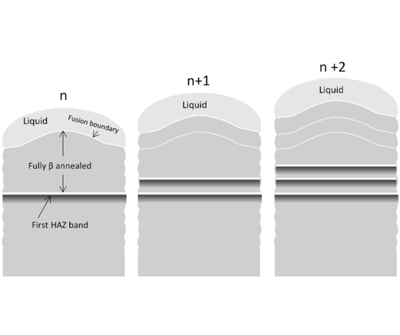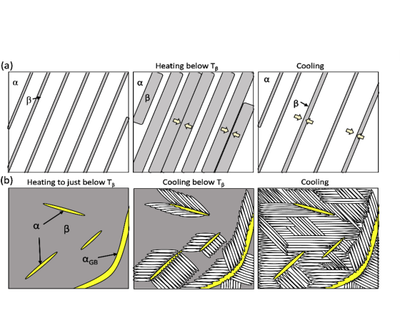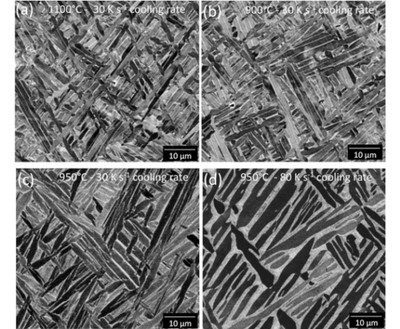


Microstructural Banding
Directed energy high deposition-rate additive manufacturing processes involve a larger melt pool diameter (∼5–10 mm) and layer height (1–2 mm) than powder bed technologies, which generally leads to greater microstructural heterogeneity and more severe Heat Affected Zone (HAZ) banding. While HAZ banding has been widely reported in AM, in this study the banding features seen in samples produced by Wire-Arc Additive Manufacturing (WAAM) have been more rigorously quantified than previously possible, using statistically reliable compositional and, purpose developed, microstructure analysis mapping tools, which has provided new insight into their nature and mechanisms of formation. In addition to HAZ banding, a segregation layer has also been discovered at the fusion boundary from each melt track. This transient segregation layer and the weak coring seen, for the first time in the AM deposits, can be attributed to the lower partition coefficient of Fe in titanium, as well as limited V and Al segregation. The detailed microstructure evolution occurring in the HAZ bands has been revisited, based on new evidence, and is shown to involve both dark and white etching bands. The lower temperature dark etching region is caused not just by an increase in the α lamellar spacing due to coarsening, but also by greater chemical partitioning with temperature rise. In addition, it is shown by thermal simulation that the thin white band occurs on re-heating to just below the β transus temperature, which is shifted upwards owing to the high heating rate in AM. This white band is associated with a morphological change to a fine α lamellar colony morphology, which exhibits less solute partitioning. The mechanisms involved are discussed. The rapid coarsening that occurs in the range of the β approach curve is attributed to interface migration from β re-growth, rather than conventional surface tension driven effects, whereas the fine colony microstructure is proposed to be caused by colony nucleation, in subsequent cooling, on a low volume fraction of residual α.
Ho, H. Zhao, J. W. Fellowes, F. Martina, A. E. Davis, and P. B. Prangnell, “On the origin of microstructural banding in Ti-6Al4V wire-arc based high deposition rate additive manufacturing,” Acta Mater., vol. 166, pp. 306–323, 2019, doi: 10.1016/j.actamat.2018.12.038.
Information
- Research Area:Material Development
- Publication date:17 January 2020
-
Investigators:
Phil Prangnell
, Alec Davis - Publications:https://doi.org/10.1016/j.actamat.2018.12.038
